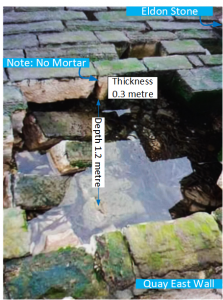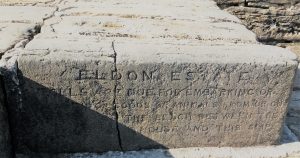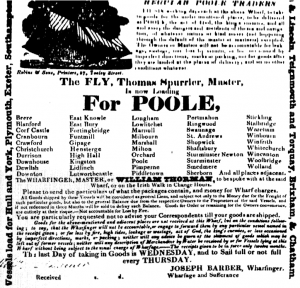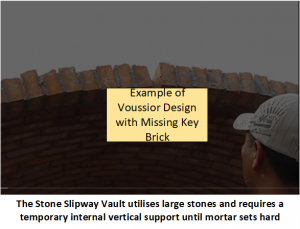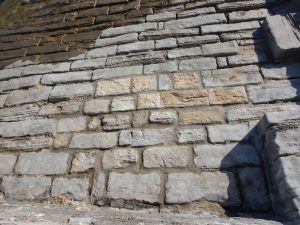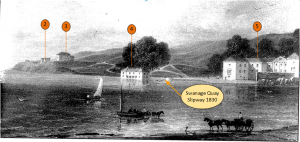Swanage Quay Slipway 1820-2021
Lord Eldon’s Slipway is a marvel of stone masonary, it has weathered all types of sea state and temperatures from minus six to 35 degrees celsius for 200 years, with only minor damage until February 2021, when about 10 blocks of stone fell into the bottom of the foundations. This has since been repaired by a local builder in September 2021.
When in the damaged state it gave an opportunity to marvel at the remarkable masonry skills of the 19th century local stone mason.
Swanage Slipway Introduction
The Stone Quay was built in 1750 on land initially owned by the very land rich Abbess of Shaftesbury. After Henry VIII dissolved the monasteries, she surrendered the Abbey in 1539. The manor was granted to John Zouche in May 1540, who is presumed to have been a relative of the former Abbess, Elizabeth Zouche.
In the middle of the sixteenth century the Encombe estate land was bought by Robert Culliford of Devon who built a house on the site of the present one, and his family owned it until 1734. When it was bought by George Pitt, who already owned Kingston Maurward near Dorchester. His son, John (1706-1787), modified Encombe House and left it to his son, William Morton Pitt7.
John Scott the Earle of Eldon, Durham, abandoned the idea of taking Holy Orders and on 18 November 1772, eloped with Elizabeth Surtees, the daughter of a wealthy banker of Newcastle-upon-Tyne. They were married on 19 November 1772 at Blackshiels near Edinburgh. They returned home and were soon forgiven by their parents who joined in giving them £3,000. The marriage was re-solemnised in St. Nicholas’s Church, Newcastle-upon-Tyne, on 19 January 17733.
In 1782, he entered Parliament for Lord Weymouth’s close borough of Weobley in Herefordshire, which Lord Thurlow obtained for him without solicitation. In Parliament he gave a general and independent support to Pitt.
In 1788, he was appointed Solicitor General, and was knighted, he attracted attention by his speeches that supported Pitt’s resolutions on the state of the King George III (1760-1820), who suffered from mental health and the delegation of his authority. It is said that he drafted the Regency Bill, which was introduced in 1789
In February 1801, the ministry of Pitt was succeeded by that of Addington, and the chief justice now ascended the woolsack. The Lord chancellorship was given to John Scott Baron Eldon6
On the 7 July 1821, George IV conferred on Eldon the titles of Viscount Encombe and Earl of Eldon. The patent was sealed on 9 July, and on the same day the new Earl took his seat in the House of Lords.
Eldon was a good friend of the Duke of Wellington, a letter from the Duke to Eldon dated 1 September 1827, describes his self-doubt in accepting the office of Commander in Chief. Eldon also corresponded with William IV (1765-1837)6.
Eldon had two sons. The elder was John (8 March 1774-24 December 1805), who on 22 August 1804 married Henrietta Elizabeth, only daughter of Sir Matthew White Ridley, bart. They had one son, John (10 December 1805-13 September 1854), who from 1821 had the title Viscount Encombe, and on his grandfather’s death succeeded to the earldom and estates3.
The younger son was William Henry (25 February 1795– 6 July 1832). There were also two daughters: Elizabeth (married on 27 November 1817 to George Manley Repton, youngest son of Humphry Repton. She died on 16 April 1862; Frances Jane (married on 6 April 1820 to Rev. Edward Bankes, rector of Corfe Castle.
In 1807, William Morton Pitt sold the Encombe estate to John Scott, Lord Chancellor and the first Earle of Eldon, but reserved for himself the estate at Peveril which had always been owned by the Encombe Estate or manor of Kingston.
In 1823, there was a Chancery sale connected to the estate of John Dampier, who died in 1811. Morton Pitt bought Lot 11 which included the Manor House lease that included the stone quay.
Although, he did not own the beach east of the quay. This was owned by John Scott, first Earle of Eldon. Who sanctioned the building of the slipway and installed the Eldon Estate Stone.
In February 2021, the Slipway was damaged by heavy seas resulting in the damage portrayed in the following image. This is not the first time this has occurred but it is the worst case.
From the above image there are some interesting observations:
The area of damage has occurred where the slipway span is at its largest, at eight metres. The Slipway Span has been designed to gradually decrease to four metres at the low tide mark.
The construction has an ecclesiastical vaulted design; the stones that have recently been disturbed by storm damage show little sign of sea weed growth.
The weed is only apparent at the sea facing edge and only two centimetre in depth, the same depth of the top layer of sealing mortar; the majority of the inter stone junctions have no mortar and held in place by the two side wall stones, known as Springer stones.
There are some stones that have weed growth, caused by erosion on the sealant, these may have weakened the structure, by loss of compressive force exerted by the central wedge stone or Key Stone. causing the partial collapse.
The remaining stones stretching to the sidewalls, are being held in place by the compressive force exerted by unaffected stones in the quay structure, this Voussior design was developed for archways centuries ago.
This design places a high compressive force on the stones leading to the Springer stone and therefore the stone deployed must have excellent inter shell cohesion. A suitable stone structure is Thornback, it comprises of small tightly compressed shells, formed 140 million years ago and extracted from the Middle Purbeck, Freestone bed. It has a pale white colour and comprises of Biosparite with Praeexogyra. This stone does not absorb water, is impervious to frost damage and is fit for purpose.
The Slipway construction date and architect had not been well documented so I have researched, provided relevant literature including extracts from correspondence between Lord Eldon and his brother and close friends and based on my review the hypothesis is:
… The Slipway was designed by George Stanley Repton and built during the period 1820 to 1825 by John Tulloch, a Wimborne builder and architect…
Literature Review
John Scott was born in 1751, was Lord High Chancellor 1801-06 and 1807-27; High Steward of the University of Oxford 1801-38 and had a daughter, Elizabeth. The Lord Chancellor was very fond of Encombe and came down as often as possible although the journey from London took three days 6.
In 1817, Elizabeth married, by special licence at St George’s, Hanover Square, without the Earl’s blessing or even his knowledge, to a church architect George Stanley Repton, the son of the eminent architect and landscape gardener, Humphry Repton. It was not until 1820, after the difficult birth of the couple’s first child, that the Eldons and the Reptons were reconciled 1.
John Scott, Earle of Eldon made use of Repton’s services as an architect on and off for the rest of his life, between 1820 and 1838. The Earle set himself the task to make improvements to Kingston, the estate village and the grounds of Encombe itself. His goal was to ensure that his village had a church worthy of his rank as Lord Chancellor, the most important of the Great Officers of State, appointed by the Monarch George IV. One example was to have a completely new church rather than to restore the old one.
Repton entrusted John Tulloch, a Wimborne builder and architect for the major design in rebuilding St James the seven-century old church; the Chapel of Ease for St Edwards Church, Corfe Castle. Tulloch subsequently worked on churches in Blandford and Lytchett Minster2.
The following correspondence, written two years after the death of Lady Eldon, in June 1831 aged 77 years. Written by Lord Eldon’s grandson Viscount Encombe (1805-1854), to Lady Bankes in 1833 verifies the authenticity of Repton’s work
.
…Lord Eldon, who had visited Encombe in February and at Easter, repaired thither again at Whitsuntide.
On this last occasion, Lord and Lady Encombe were with him from Saturday the 25th of May to the Wednesday following. This was Lady Encombe’s first visit there: and on Sunday the 26th, the newly built chapel at Kingston, which is a chapel of case for the parish of Corfe Castle, was opened for divine service, the solemnity being attended by Lord Eldon, Lord and Lady Encombe, and other members of the family.
The old chapel had been a rude, ill-constructed building, the walls of which, though thick and clumsy, were by no means impervious to damp. The present edifice, which is of a plain Gothic character, was designed by Mr. Repton, and executed under his superintendence, at the expense of Lord Eldon, by virtue of a faculty from the Ecclesiastical Court… 6
As part of the Eldon Estate, a Slipway was constructed next to the much older Swanage stone quay built in 1750. It has an ecclesiastical vaulted design that would be very familiar to the architect and builders who would later reconstruct St James Church.
An example of the vaulted design, was the 1832 specially constructed family vault in the north side of St James churchyard of the nearly completed church. This was where the Earl’s wife and son were buried. The Church was completed in 1833.
In 1825, Morton Pitt extended the quay by placing two rows of Roach Stone around its sea defence walls and, in a period, when the Encombe Estate was being refurbished under the local stewardship of Mr. Willis (1767-1849).
The Slipway Construction and the Eldon Estate Stone.
The following image is the engraved Eldon Stone, that straddles the beach entrance to the slipway, it is weathered well considering it’s been there for approximately two centuries. The text is undecipherable at the bottom, but luckily the missing words were found in David Lewer D and Smale D book Swanage Past 9.
ELDON ESTATE
TOLLS ARE DUE FOR EMBARKING OR LANDING
GOODS OR ANIMALS FROM OR ON
THIS SLIP OR THE BEACH BETWEEN THE
PIER TOLL HOUSE AND THIS SLIP
Reasons for Slipway Construction
John Scott Earle of Eldon moved to London in 1775, finally living in Hamilton Place. Eldon devoted his days and nights to professional study which for a time seriously impaired his health. His wife Elizabeth in later life moved to Encombe House due to her poor health.
John Scott the Earle of Eldon, Lord chancellor until 1827 would have required a means of transport to London when Parliament began sitting during the period 1807 to 1827. During the sitting he stayed at his London Residence at Hamilton Place.
The fastest mode of travel during this period would have been by sea. For example, when George Burt (1816-1894) travelled to London he travelled to Branksome pier via the local Swanage boat service, that ran three times a week, changed to a ship bound for Portsmouth and then a Stagecoach to London, in all a three-day journey.
There are numerous reasons for the Slipway construction:
1. Receiving goods from London and the surrounding locality. The alternate bay nearer Encombe House called Freshwater Steps was subject to high seas.
2. Exporting Live Stock to local towns such as Poole, a maritime hub in the 19th century.
3. In 1820, the Earle was 69 years old and less agile, perhaps it made his journey less arduous.
4. To develop his land to ensure no one encroached upon it.
5. Impede later development by other parties.
The slipway viability was assisted by its close proximity to Poole docks, the following image depicts a London advertisement (created around 1820’s) promoting the regular London to Poole Trade, made by Joseph Barber, Wharfinger of Chamberlains Warf, Southwark, London (a person who owns or manages a wharf).
It provides a list of Dorset Towns that include Kingston, Corfe Castle and Swanage.
The Death of Lord Eldon’s Wife
This slipway would have been used by the aristocracy in 1831 when Lord Eldon’s wife died on 28th of June 1831, the long illness under which Lady Eldon had been suffering put an end to her life.
An extract from the 1844 book The Public and Private Life of Lord Chancellor Eldon with Selections from his Correspondence
In a July 1831 letter from Lord Eldon to Lord Stowell his brother,
…My ever-dear Brother, “Your letter reaches me in a flood of tears and a sort of burst of agonizing feeling. I submit as well as I can–I fear not as well as I ought — to God’s will. But I will do my utmost to acquire the means of doing my duty. I am quite sure that our meeting as yet would overpower me; and I fear also, you, — that you are the person who is the object of all my affections and anxieties along with my offspring…6
St James Church Grave Yard Consecration
In a July 1831 letter from Viscount Encombe to the Encombe steward Mr. Willis
…“Immediately upon Lady Eldon’s death,” states Viscount Encombe “Lord Eldon formed the wish that a family vault should be prepared at Kingston, in his parish of Corfe Castle, Dorset, where he might, as he expressed it in a letter to his steward Mr. Willis, repose with her till the hour of death is followed by the day of judgment. Instead of occupying a part of the existing chapel-yard to the partial exclusion of the other parishioners, he preferred applying land of his own to that purpose.
In the meantime, a temporary vault was made for the remains of Lady Eldon in the chapel near the Communion Table: there they were deposited on Saturday, July 9th, 1831, my uncle William H. J. Scott, Mr. Edward Bankes, Mr. W. V. Surtees, myself, and others, attending as mourners…
Having applied to the Bishop of Bristol, whose diocese then comprehended Dorsetshire, to consecrate the new ground, Lord Eldon received from him this kind and pious answer:
…My Dear Lord, “Great George Street, July 9th, 1831.
“I read, with painful reflections and sympathy, your Lordship’s affecting letter, and am anxious to offer any suggestion which the moment can dictate, of consolatory consideration. A great deprivation you have indeed sustained; but who, my dear Lord, is so supported by the strong convictions of an enlarged mind to bow to, and to adore, the dispensations of Providence?
Who is more faithfully convinced of the mercies of a Redeemer and of the inspiration of those writings in which his proceedings are disclosed?
I shall most readily undertake to consecrate the ground at the time that may be most grateful to your Lordship’s feelings. I will consider whether it can be affected during my present visit in Dorsetshire, so as not to prevent my return to London by the 2nd of August; or I will at any future time visit your Lordship for the express purpose; I shall be happy to communicate again with your Lordship in a few days, as I do not leave London till Saturday. I remain,
My dear Lord,
“ Most sincerely and faithfully yours…,6
Joseph Willis (1767-1849) was Lord Eldon’s steward or agent for 50 years, 31 years at Encombe.
Towards the end of August 1831, Lord Eldon yielded to the strong impulse of indulging his grief in a visit the burial place of his wife.
He left London on Saturday the 27th, slept at Southampton, and reached Encombe on the Sunday6.
Early on the Monday morning he wrote to his brother.
Extract of letter from Lord Eldon to Lord Stowell.
“Encombe, Monday,
(Postmark 29th August 1831.)
“I arrived here last night. My first approach to this place, so often the scene of great happiness in former days, has, at present, most deeply and painfully affected me. I shall have many trials during my short stay here, which I know not how to bear. I have, however, designedly exposed myself to this present state of suffering, because, some time or other, if I live, I must meet what I have at present exposed myself to.
“I pray God, daily and incessantly, for all that can contribute to your health, comfort, and happiness, and am with all possible affection,
Yours, dear Brother,
ELDON.”
Extract of letter from Lord Eldon to Lord Stowell
(Postmark, July 4th, 1832.) “Wednesday”.
“My son is in a most critical situation. Pennington told me yesterday, that four or five days will decide, whether he will recover, or whether a termination must come, the apprehension of which overwhelms me, in the state in which I am myself. Poor fellow! he has sent to me to express his wish that I should take the sacrament with him.”
On the forenoon of that day, Lord Eldon, his son, and his daughters, took the sacrament together at William Henry’s house in Park Street: and there, early on the morning of the Friday, William Henry breathed his last.
Lord Encombe, on receiving the news, hastened to Lord Eldon, in Hamilton Place, where he found several members of the family assembled at the breakfast-table. William Henry’s death had thrown his failings into the shade and brought his virtues into relief, in the view of his sorrowing father. “Well,” said Lord Eldon, “I must say of him, that whatever faults he had, and however unfortunate they were for me, he had the best heart of any man I ever knew in my life.”
On the 13th of July 1832, the family vault at Kingston was now complete. Lady Eldon’s remains were removed to it; and on the following morning those of William Henry were laid there6.
The Death of Lord Eldon 1838
The following describes the funeral Cortege of Lord Eldon in 1838, he died on 13 January and provides an example, of how slow the journey from London to Encombe was by road
…On the morning of 22nd January, the funeral procession prepared to set forward from Hamilton Place, in its way to Encombe. Before it was ready to depart, a vast crowd had assembled in Piccadilly. The carriages of the Duke of Cambridge and the Duchess of Gloucester, and of most of the dignitaries of the law, as well as of many other noblemen and gentlemen, attended, in addition to those of relatives and of immediate friends.
About half-past eleven, the hearse received the body, and moved from Hamilton Place into Piccadilly, followed by the mourning coaches. A majority of the people stood respectfully uncovered, while the closed windows of numerous residences in the neighbourhood gave token of similar veneration and regret. The chief mourner was the present Earl. The funeral line proceeded slowly for some distance along the Hammersmith Road. It then made a halt, and was acquitted by the private carriages, which returned to London. The main procession rested on that night at Bagshot.
Tuesday at Winchester.
Wednesday at Wimbourne.
On the Thursday morning it reached the family mansion at Encombe, where, during the remainder of that day, the body lay in state.
The bell of Winchester Cathedral was tolled by order of the Dean and Chapter on the Wednesday morning, as the funeral moved from the town: and in the more immediate vicinity of Encombe, where the Earl had been generally known, almost every house was wholly or partially closed.
Next morning, Friday, January 26th, his remains were borne to the family vault, in the burial-ground of the chapel at Kingston, in which had been deposited those of the late Countess, and of their son William Henry. A great concourse of the country people had assembled to see the train set forward, and they evinced, in their silent, respectful, and solemn demeanour, their deep regret for their charitable neighbour and generous benefactor.
Thus, after a long and honoured life, was John Earl of Eldon gathered to his kindred. He “came to “his grave in a full age, like as a shock of corn ” cometh in his season.” His memory will live long in the hearts of his friends, and for ever, in the history of his country…6
Conclusions
Morton Pitt sold the Encombe Estate in 1807 to the Scott Family, but reserved for himself the estate at Peveril which had always been owned by the Encombe Estate.
The Stone quay was built in 1750 at a cost of £300 from the Parish and local stone workers provided stone and a day’s work. It was owned by the parish and people drew drinking water from a spring called Boil Well9.
Although, Pitt owned the freehold of the Mansion House hotel and the quay the property was leased to John Dampier. It wasn’t until 1823, when he purchased the lease from the Estate of Dampier, who died in 1811. Up to 1823 no slipway could be built by Lord Eldon, Viscount Encombe and Earl of Eldon, because the adjoining quay was still part of Dampier’s estate.
Repton was aware that building a replacement church would have required tons of well-seasoned oak for the roof beams. There was no local source so he would have to import the timber, this would require suitable docking at the nearest sea port, Swanwich.
Once he gained access to the stone quay in 1823, he designed the structure based on his experience by virtue of a faculty from the Ecclesiastical Court. This structure would use the principles applied to the construction of the Scott family vault at Kingston built later in 1832, as detailed in the Extract of letter from Lord Eldon to Lord Stowell 4 July 1832.
This design required two side walls, at the west end north wall eight metres from south wall and at east end north wall four metres apart from south wall, built from the quay down to the low water mark, using deep foundations. Then a building block support made of a perishable material, for example, a wooden Former with a detachable base, that could be knocked clear of the structure when the rank of stones was aligned correctly. This Former could be reused by using a smaller or larger detachable base. This would have been placed into the void between the bottom of blocks and dry sand beach below. This would provide a malleable base for the stone blocks, the Springer Stones and the stones leading to the Key Stone, would be held in situ by the Former to ensure the convex base of the slipway was correct before the Key stone was inserted
In the course of time the supporting malleable base would decay away and gravity and friction would secure the structure.
The Thornback stone blocks deployed weigh 23 Kg and are 300 cm long. This design allows the beach sand at the base of the structure to mirror the height of the external sand, that is dependent on tidal and weather conditions.
The complete construction would have required numerous standard length and breadth blocks and additional shorter blocks to cater for the slight, seven-degree, camber from the centre. These blocks could have been manufactured off site so that time wasted by tidal movement wouldn’t have been such an issue.
The construction would start, by positioning the Springer wall block, then a line of blocks would be inserted until arrival at the space for the Key Stone. This would be repeated from the other wall until all blocks in the rank were in position, as shown in the previous brick example image.
The Thornback stone is accessible at East Lynch, a farm of about 345 acres, situated on the slope of the hill, a little below and to the south of Kingston was included in 25 April 1807 purchase of the Encombe estate10.
Morton Pitt extended the quay in 1825, by placing two rows of Roach Stone above the original quay floor to protect his hotel clientele, but this would have impeded access to the top of the slipway and forced users to access the Eldon Slipway via the beach and the steps. This would have been difficult if transferring livestock onto the slipway. Therefore, building the slipway after 1825 may not have been such a viable proposition, but tenable when the tide is low and the beach is not deep shingle, which was the case in 1950-60’s.
When the slipway was operational, possibly transferring sheep, there may have been a wooden ramp available. It would account for the large Eldon stone that sits at the Slipway beach exit, at a height of 34cm, breadth of 103cm and length 1.2 metres. This ramp would have had wheels that allowed it to be pushed out onto the beach and the stone would have been a wheel anchor along with a standard wheel braking wedge. This design would also be a deterrent to people who refused to pay the toll charge, especially when the unattended ramp’s wheels were chained to the ramp whilst stored at the top of the slipway. It’s certainly not designed for the comfort of foot passengers without the assistance of a ramp.
Lord Eldon was very fond of Encombe and came down as often as possible although the journey from London took three days7.
This was completed in two days in August 1831.
From the extract of a letter written the end of August 1831, from Lord Eldon to Lord Stowell
Stated that he yielded to the strong impulse of indulging his grief in a visit to the burial place of his wife because he had not attended, the funeral in June 1831
He left London on Saturday the 27th, slept at Southampton, and reached Encombe on the Sunday.
Early on the Monday 29th morning he wrote to his brother, Lord Stowell6.
He would have travelled to Southampton by a private Stage coach, that travelled at nine miles an hour and stayed at an hotel. On Sunday morning he hired a Yacht, with armed personnel and sailed to the Swanwich slipway.
;
Reference
- Hannay C. 2015 Dorset Life: Kingston and Encombe Pub: Dorset, Corfe Castle, Rempstone [Online] Available from: https://www.dorsetlife.co.uk/2015/04/kingston-and-encombe [Accessed 9th Oct 2021]
- Trueman C. 2017 Dorset Life: Kingston other Church Pub: Dorset, Corfe Castle, Rempstone [Online] Available from: https://www.dorsetlife.co.uk/2017/10/kingstons-other-church [Accessed 9th Oct 2021]
- Bloy M 1949 2016 John Scott, first Earl of Eldon (1751-1838) [Online] Available from: http://www.historyhome.co.uk/people/eldon.htm [Accessed 20th Dec 2021]
- University of Nottingham John Scott, 1st Earl of Eldon (1751-1838; Lord Chancellor) Manuscripts and Special Collections [Online] Available from: https://www.nottingham.ac.uk/manuscriptsandspecialcollections/learning/biographies/johnscott,1stearlofeldon(1751-1838).aspx
- Wikipedia John Scott, 1st Earl of Eldon, PC, QC, FRS, FSA [Online] Available from: https://en.wikipedia.org/wiki/John_Scott,_1st_Earl_of_Eldon.[Accessed 20th Jan 2022]
- Twiss H. 1844 The Public and Private Life of Lord Chancellor Eldon with Selections from his Correspondence. Vol III Chapter 54 Pub: London, John Murray, AlbeMarle Street.
- White M. 2009-2021 Encombe House [Online] Available from: http://www.kingstonopc.org.uk/buildings-places/Encombe-House [Accessed 10th Oct 2021]
- White M. 2009-2021 Kingston Old Church [Online] Available from: http://www.kingstonopc.org.uk/buildings-places/church-old [Accessed 10th Oct 2021]
- Lewer D. Smale D 1994 Swanage Past Pub:Chichester, Phillimore & Co LTD
- Beamish D. Dockerill J. Hillier J. 1974 The Pride of Poole 1688-1851 Pub: Guildford, Biddles Ltd
